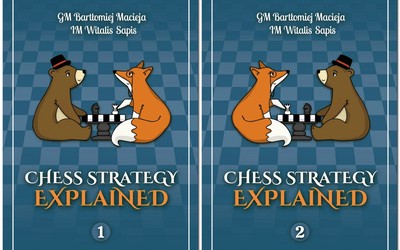
Witalis Sapis
Chess and life
Chess and life I decided to summarize the information about why I decided to write books and what principles I follow when writing, publishing and selling them. Of course, I realize that not everyone will like them and therefore they will not buy my books. However, I decided that if I followed the beaten path, the whole project would be of little interest to me.
I decided to summarize the information about why I decided to write books and what principles I follow when writing, publishing and selling them. Of course, I realize that not everyone will like them and therefore they will not buy my books. However, I decided that if I followed the beaten path, the whole project would be of little interest to me.
I
1. I have the personality of a protagonist. This personality is characterized by the desire to seek new solutions. Experiments, of course, do not always succeed, just as you cannot always win in chess.
2. In my opinion, chess is a model of life, although due to its clear rules it is much more difficult to cheat. The opponent will immediately point out the errors in our reasoning.
3. I decided to put my knowledge and over 40 years of experience on paper because I realized that others could benefit from it.
4. I decided to do it on my terms and it's a great adventure.
5. I publish books when they are of acceptable quality to me.
6. After selling 1,000 books in Poland, I decided that they also have a chance in the world and that is why I am now commissioning their translation.
II
1. In my books I present my ideas, knowledge and experience using examples from my games.
The books are therefore original and fully reflect my creative personality.
2. I publish books myself because the conditions offered by publishers do not suit me.
Publishers offer authors about 5-15 percent of the book price, which in the case of chess books is of little interest to the author.
Most often, they would also like to improve the content or change the covers so that the books they publish look similar. So there is a conflict of interest here, because my goal is for my books to be original and definitely different from others.
3. I sell the books myself because the conditions offered by the sellers do not suit me.
Sellers would like to profit from the sale of 40-60 percent of the book's price, which I find unacceptable. Moreover, thanks to self-selling, I have greater contact with readers. I offer an autograph or dedication to those interested, although in the future, in the case of larger numbers of recipients, this will be impossible for technical reasons.
4. I set the prices of books myself.
The exception is the experiment with the publication of the e-book "How to look at chess so as not to substitute pieces", where I suggested that the reader set the price himself.
In my opinion, the price of the book, comparable to the cost of one hour of training, is a very good price.
5. Book covers are based on my ideas.
The basic character on them is a fox, which, through my name, is a reference to the fairy tale “The Mischiefs of Vitalis the Fox” . Some covers also contain references to my musical fascinations.
The cover of "Chess Master's Endgame Strategy" refers to the cover of the Genesis album "Foxtrot", and the cover of "Playing Techniques" refers to the cover of Cat Stevens' album "Tea for the tillerman".
Items from my games appear on the covers:
On the cover of "Chess Master's Endgame Strategy" by Vanheste - Sapis Wijk Aan Zee 1985, and on the cover of "Playing Techniques" by Sapis - Matlak Marek Szczecin 1986.
6. The books have hard covers and are sewn.
The first editions of the books were in soft covers and glued. This was due to the lack of funds to invest in better quality.
7. I publish books in the following languages: Polish, English and German.
8. Each book has about 200 pages.
There is no denying that publishing thicker books is less economically profitable.
9. Fragments of the books can be found on my website https://witalis-sapis.com/
III
Inspirations and ideas
III a. The inspiration to write "Chess Master's Strategy" was the book "Strategic Motifs" by Anatoly Terekhin. Then expanded by the addition of co-author Walery Bronzik. Incidentally, an interesting similarity to my extended version, i.e. "Chess Strategy Explained", created together with Bartłomiej Macieja.
Terekhin's book immediately made a great impression on me, and in particular I liked the idea, which, in line with my analytical way of thinking, I decided to improve.
1. I found that the book was a mess and decided to classify the themes into sections:
- weakening of the opponent's position
a) restricting the opponent's pieces
b) weakening of the pawn structure
c) Hobit
d) disappering move
-improving your own position
a) opening files
b) peregrination of the king
c) improving the pieces
d) transfer of the queen
e) occuping the outpost
-prophylaxis
-exchanging pieses
2. I entered my names for the theme parts. I also used some of the names that already exist.
There are 9 themes in Terekhin's book:
-disappearing move – I used it
-pendulum - I changed it to the shuttle, and then to the Hobbit
-spare spare – I didn't use it
-opening the line – I used it
-breakwater – I didn't use it
-evacuation of the king - I changed it to peregrination of the king, because I decided that this motive does not have to consist only in securing the king, sometimes the king is an attacking figure
-imaginary (intuitive) pawn victim - I didn't use it
-barrier - for me this motif has a much broader scope and is called limitation
-fxg – hxg – I didn't use it
3. I used examples from my own games, while Terekhin mainly uses classical games of world champions and grandmasters. The assessment of this action may vary. For some this will be a big plus, as the book gains in originality, and for some it will be heresy.
4. Since some parts appear several times in the book, using my passion for puzzles and logical riddles, I created a system of marking them. Objectively, the benefits of this solution are not very great, but it was an interesting challenge, and that is what makes the book unique.
5. I have included records of all the batches used. Undoubtedly, searching for them on your own would be quite risky and would certainly result in a big waste of time (with no guarantee of success). However, these entries are placed at the end of a given section so that you can focus on a specific example.
6. I tried to post specific comments, avoiding "journalism" and descriptions, which slightly offended me in Terekhin's book. On the other hand, some readers suggested that this was missing from my book.
III b. "Chess Strategy Explained"
An extended version of the book "Chess Master's Strategy" prepared with grandmaster Bartłomiej Macieja, mainly for the American market. Compared to the original, it contains twice as much material because we added Bartek's parts to mine. Moreover, it covers items created in a much larger number of debuts. Due to the amount of material, it is divided into two volumes.
Objectively, I must admit that the book is better than the original, because in my opinion Bartek is a chess genius who had the predispositions to become world champion. However, postponing the decision until the last minute (due to the search for the perfect solution) did not allow him to achieve it. This also became one of the main reasons for ending our cooperation.
Coming soon:
III c. "Chess Master's Endgame Strategy"
Endgames are the final phase of a chess game. Sometimes we can gain a minimal advantage or save a difficult position. Nowadays, when you play games without overtime, you need to have much more knowledge about the endings
than before. The idea of the book is to create a database of endings and motifs that appear in them.
III d. "Playing Techniques"
The book shows the rules that must be followed to understand what is happening on the chessboard. From my experience, the most important of them are:
-looking at weaknesses
-the order in which moves are considered.



